#ferdinand i of naples
Text
#JON SNOW FORTNIGHT EVENT 2023 @asoiafcanonjonsnow
DAY 10: ECHOES OF THE PAST 🗝️📜 (1/2) ->
Historical parallels with Medieval bastard Kings.
Nowadays, ‘bastard’ is used as an insult.
Being born to unmarried parents is largely free of the kind of stigma and legal incapacities once attached to it in Western cultures, but it still has echoes of shame and sin. The disparagement of children born outside of marriage is often presumed to be a legacy of medieval Christian Europe, with its emphasis on compliance with Catholic marriage law.
Yet prior to the 13th century, legitimate marriage or its absence was not the key factor in determining quality of birth. Instead, what mattered was the social status of the parents – of the mother as well as of the father. Being born to the right parents, regardless of whether they were married according to the strictures of the church, made a child seem more worthy of inheriting parents’ lands, properties and titles.
It’s not until the late 12th century that evidence for the exclusion of children from succession on the grounds of illegitimate birth first appears. ‘Bastard’, as we now understand it, began to emerge here.
Importantly, this shift in the meaning and implications of illegitimacy did not arise as an imposition of Church doctrine. Instead, ordinary litigants began exploiting bits of Church doctrine to suit their own ends. Perhaps the earliest signs of this can be found in the annals of English legal history, with the Anstey case of the 1160s. This might have been the first time an individual was barred from inheriting because her parents had married illegally. And it happened not because the Church intervened, but because one clever plaintiff figured out how to exploit some scraps of theological doctrine. After that time, more and more plaintiffs began to do the same.
For example, towards the end of the 12th century, a regent countess of Champagne rushed to make use of an allegation of illegitimate birth against her nieces, in an effort to secure her son’s succession. Daughters could inherit in this region, and so these sisters did have a claim to the county once ruled by their late father. But the regent countess denounced the sisters as the product of an illegal marriage and therefore not legitimate heirs of their father. The strategy worked in that both daughters did eventually renounce their claims to the county, but not without first obtaining a great deal of money, enough to make them both extremely wealthy. As this suggests, the papacy had a far more passive role than is often imagined.
As bastardy began to acquire its modern meaning, in the early 13th century, it remained the case that the papacy focused on the regulation of illicit unions rather than the exclusion from succession or inheritance of those born to illicit unions. Hatred of illicit sex did trump dynastic politics on occasion. Hatred of the children born to such unions did not. There is very little evidence to suggest that an interest in keeping illegitimate children from inheriting noble or royal title outweighed political or practical considerations in the same way that the policing of illegal marriages sometimes did.
Understanding the changing meanings of bastardy helps us to arrive at a clearer picture of the workings and priorities of medieval society before the 13th century. Society then did not operate subject to rigid Christian canon law rules. Instead, it measured the value of its leaders based on their claims to celebrated ancestry, and the power attached to that kind of legitimacy. To be sure, marrying legitimately certainly received a good deal of lip service throughout the Middle Ages. Nevertheless, in this pre-13th-century world, the most intense attention was paid not to the formation of legitimate marriages, but to the lineage and respectability of mothers. Only beginning in the second half of the 12th century did birth outside of lawful marriage begin to render a child illegitimate, a ‘bastard’, and as such potentially ineligible to inherit noble or royal title.
Source
Well, George R.R. Martin has been using real life historical events as an inspiration for creating the lore of A Song of Ice and Fire, more concretely English and Western Late Medieval Europe history for Westeros, and it was precisely in the Late Middle Ages when the legal situation for bastards worsened by reinforcing marriage and legitimacy laws, reinforcing concubinates to disappear and laws to avoid any kind of polygamy.
In Westerosi society there's the stigma that comes from being born as a bastard, they're said to be born from lust, lies, and weakness, and as such, they are said to be wanton and treacherous by nature, and although they could get some prominent position either in the Citadel, the Kingsguard, Night's Watch or the Faith, they are generally discriminated by other Westerosi (except in Dorne, where there's tolerance towards bastards) and they rarely inherit his father's titles nor become kings. In the Asoiaf lore, there's recording of a bastard of a Bracken and a Blackwood, Benedict Waters, who founded the House of Justman and became King of the Trident as Benedict I; as well as Alyn Velaryon, a Velaryon bastard who was legitimised and became Lord of the Tides after The Dance of Dragons.
Till the events of the published books, Jon has reached the position as Lord Commander of the Night's Watch and King Beyond the Wall in all but in name, two positions he has been chosen for.
But he would not have the possibility to inherit any title as Lord of Winterfell and Warden of the North/King in the North as a bastard, unless someone legitimised him, like Robb did in his Will. Jon has the chance of standing as a candidate for the Northern Succession Council after defeating the Boltons.
So, if The North stays away from the Iron Throne, Jon would be a good candidate for Lord of Winterfell and King in The North, but the question is... Is there any historical example of bastards who became kings?
Yes, there are, and in this meta we're going to down through history and remember those kings. This list probably doesn't include all of the bastard kings, just a selection, if you know about some more, feel free to share it.
The most common concept for bastardy is a child born of parents who were not married when the child was born, so firstly we'll list a few kings who are included in that group, as we consider Jon as Eddard Stark's bastard or Rhaegar and Lyanna's.
Their circumstances in which those kings got to throne are diverse, but we'll get into them searching for any simmilarities between Jon's story and their lifes.
Let's start, the list is on chonological order, and we'll notice that after the 13th century the amount of bastard kings is less, like we cited at the beginning of this meta.
8th Century
-> Mauregato I of Asturias (719-788), who reigned during the late 8th century, between 783 and 788, and was the son of Alfonso I of Asturias and a Muslim concubine or servant named Sisalda. He took the throne when the nobility had declared his nephew Alfonso II of Asturias as Silo's successor, although he probablyhad support of some parts of the nobility. He wed Creusa and had a son with her, Hermenegildo. Bermudo I was elected as King of Asturias after Mauregato died.
The identity of Mauregato's mother is a bit unclear, but her being a Muslim servant is considered a common statement, so his parents followed religions, Christianism and Islam, like Rhaegar and Lyanna, the Faith and the Old Gods.
Plus as happened to Mauregato, Jon may have some problems of nobles in the Northern Great Council because he's bastard and the other candidates would have support for being legimate, although they are kids, they would need a regent, that could be beneficial for them to control the North if they want to, but maybe some other members of the Council suggest or support Jon as their leader.
11th Century
-> Ramiro I of Aragon (1006/7-1063), natural son of Sancho III of Pamplona and Sancha de Aybar. His father Sancho splited his domains and passed down one of them to his sons; from the offspring she had with his wife Muniadona of Castile: García III inherited the Kingdom of Pamplona, Ferdinand I of Leon inherited the county of Castile and Gonzalo inherited the counties of Ribagorza & Sobrarbe; and Ramiro received the county of Aragon, and he annexed the counties of Ribagorza & Sobrarbe Gonzalo died. He unified the three counties to create the Kingdom of Aragon. His relationship with his siblings was complex, due to the rivalry between them for their kingdoms, initially Ramiro tried to conquer Pamplona but he was defeated by García III, and later Ramiro allied with García and his son Sancho IV against Ferdinand I.
His reign lasted 28 years.
Ramiro married Ermesinda of Foix and Agnes of Aquitaine, their offspring was: Sancho I of Aragon & V of Pamplona, Sancha, García, Urraca and Theresa, and he had a son named Sancho out of wedlock.
-> Magnus I " the Good" of Norway and Denmark (1024 - 1047), son of Olaf II of Norway and English concubine named Alvhild. His reign lasted 12 years. When he was 4 year old, his father was dethroned by Cnut the Great, and then his family travelled through other courts seeking shelter but finally they stablished in at the court of the Grand Prince Yaroslav I of Novgorod, where he grew up, was trained as a warrior and was educated in Old Russian and Greek. Olaf was killed when he reurned to Scandinavia to fight for the throne. When Cnut left for England wife Ælfgifu and their son Svein as regents, Magnus and his supporters return to Norway and he was proclaimed king of Norway. Another son of Cnut, Harthacnut of Denmark, reclaimed Norway, but after Harthacnut died Magnus took his kingdom, but he had to face another pretender Sweyn II, Cnut's nephew, whom Magnus battled against using his father's battle axe, Hel, and he was successful, but died, and Sweyn II succeeded him as King of Denmark and Harald III as King of Norway.
-> William I the Conqueror (1028-1087), illegitimate son of Duke Robert I of Normandy and Herleva of Falaise. He was duke of Normandy and conqueror and king of England.
He started the conquest of England after his cousin, Edward the Confessor died without issue, and Harold II inherited the English throne, but he was defeated and William became the first king of England of the House of Normandy.
William and his wife Matilda of Flanders had 9 children: Robert I of Normandy, Richard, William II of England, Henry I ofEngland, Adelaide, Cecily, Matilda, Constance and Adela .
William seems to be the inspiration for Aegon I the Conqueror and his bastard brother Orys Baratheon, but he could have in common with Jon in becoming kings after their cousins died without issue (i.e. Robb) and having to defeat someone else to become kings, i.e. Jon helping Stannis to defeat the Boltons.
-> Harald III "Hen" of Denmark (1040-1080), illegitimate son of Sweyn II of Denmark and a concubine, Thora.
After Sweyn II died, Harald got elected over his brother Cnut by an assembly, and faced opposition from his brothers during his reign. He ruled over 6 years, he's known to be a peaceful ruler and introduced some monetary and legal reforms like substituting trial by combat or trial by ordeal and replace it with avsystem used by the English of calling upon honorable men to swear oaths on behalf of the parties in a trial.
Harald was married to his cousin Margareta Hasbjörnsdatter, but did not leave any heirs, and was succeeded by his brother Canute IV.
-> Cnut IV "the Holy" of Denmark (1040-1086), illegitimate son of Sweyn II of Denmark with an unknown concubine. He succeeded his brother Harald.
Cnut is considered an ambitious and strict king, ruled during 6 years, limited the power of the nobility, gave great concession and donations to the Church, and took the property of a great quantity of common land for himself or the Church. He raided England a few times and created a fleet to invade it, since he considered William I an usurper, but on his way to lead the invasion, he was killed during a peasant revolt.
After he died, he was succeeded by his brother Olaf I of Denmark.
Cnut married Adela of Flanders. They had three children: Charles I of Flanders and the twin sisters Cæcilia and Ingerid. Ingerid's descendants, the House of Bjelbo, would ascend to the throne of Sweden and Norway and Canute IV's blood returned to the Danish throne in the person of Olaf II of Denmark.
->Olaf I "Hunger" of Denmark (c. 1050 – 1095) illegitimate son of Sweyn II of Denmark with an unknown concubine.
In his early years he was set aside and mistreatred and exiled by his brothers, who Ferrer he could be a political rival against them.
He succeeded his brother Cnut IV, and his reign lasted 9 years, that were plagued by several consecutive years of crop failure and famine.
Olaf married Ingegard of Norway, they didn't have any offspring, so he was succeeded by his brother Erik I.
11th Century/12th Century
-> Erik I " Evergood" of Denmark (c. 1060 – 1103), illegitimate son of Sweyn II of Denmark with an unknown concubine.
When he was young he was a supporter of his brother Cnut IV. After Olaf died, Erik was elected as new king.
Erik reign lasted 8 years, he was well liked by people, he was considered a strapping young man and a good speaker and diplomat, and ruthless towards pirates and robbers. Erik had a reputation as a loud man who liked parties, and even killed four of his men while he was drunken during one of his parties, and so he procced to go on pilgrimsge to Holy Land, journey in which he died. His brother Niels succeeded him.
Erik married Boedil Thurgotsdatter and had one legitimate son with her, Canute Lavard, father of Vademar I of Denmark. Eric had four children out of wedlock, Erik II of Denmark, Benedict, Harald Kesja and Ragnhilde, mother of Erik III of Denmark.
-> Niels I of Denmark (c. 1065 – 25 June 1134) illegitimate son of Sweyn II of Denmark with an unknown concubine. He was the last son of Sweyn to become king.
He was described as mild and forthcoming, though not a competent ruler.
Niels married Margaret Fredkulla, and had two children with her, Inge Nielsen and Magnus I of Sweden. He had a daughter born out of wedlock, Ingerd of Denmark.
During the majority of Niels' reign, 30 years, Denmark had internal peace, only broken when his son Magnus was forced from the Swedish throne and a conflict erupted between Magnus and his cousin Cnut Lavard, due to his popularity. After Magnus slew Cnut, Erik II took his brother's place in the conflict, and Niels supported Magnus.
Niels and Magnus died during the civil war and Erik II became king of Denmark.
-> Erik II "the Memorable" of Denmark (c. 1090– 1137 ), illegitimate son of Eric I of Denmark with an unknown concubine.
Erik the Memorable rebelled against his uncle Niels, and was declared king in 1134.
He punished his adversaries severely, and rewarded his supporters handsomely, as he was considered a harsh and unpopular ruler, he only ruled Denmark 3 years. He was killed by a subject in 1137 and was promptly succeeded by his nephew Erik III of Denmark.
Erik married Malmfred of Kiev, they had no issue, but Erik had a son with his concubine Thunna, Sweyn III of Denmark.
12th Century
-> Sweyn III of Denmark (1125-1157), illegitimate son of Erik II of Denmark and a concubine named Thunna.
He was elected king after Erik III of Denmark abdicated.
In 1154, Sweyn was overthrown by an alliance between Canute and Valdemar, who was crowned Canute's co-ruler as Valdemar.
This prompted the Danish magnates to force through a tripartition of the kingdom into Jutland, Zealand, and Scania. Sweyn chose first, and was made the ruler of Scania.
After that Sweyn organised apeace banquet, in which Sweyn planned on killing his two co-rulers, and succeeded in having Canute killed, but Valdemar escaped. After that Valdemar and Sweyn battled, Sweyn was killed while he was scaping from the battle. Valdemar I was proclaimed king of all Denmark.
Sweyn married Adela of Meissen, daughter of Conrad, Margrave of Meissen, and Luitgard of Ravenstein. They had two children Erik and Luitgard, who married Berthold I of Istria.
->Tancred I of Sicily ( 1138 – 1194), or Tancred of Lecce, illegitimate son of Roger III, duke of Apulia, eldest son of Roger II of Sicily, and his mistress Emma of Lecce.
Tancred was born in Lecce and inherited the county from his grandfather.
With his bastard uncle Simon plotted to remove William II, legitimate son of Roger II, but failed and went to exile.
Years after, Tancred returned to Sicily he swore fealty to his aunt Constance I as William II's heiress, Tancred rebelled and was crowned as King of Sicily. Constance I and her husband the Holy Roman Emperor Henry IV fought against Tancred. Tancred died during the war after 5 years of reign, and was briefly succeeded by his son William III, who was soon captured and executed by orders of Henry IV.
Tancred had married Sybilla of Acerra, an their children were: Roger III, William III, Elvira, Constance, Medania and Valdrada.
13th Century
->Manfred I of Sicily (1232 – 1266), natural son of Holy Roman Emperor Frederick II with Bianca Lancia, legitimised later by his father.
Manfred became regent over the kingdom of Sicily on behalf of his nephew Conradin. As regent he subdued rebellions in the kingdom, until in 1258 he usurped Conradin's rule. After an initial attempt to appease Pope Innocent IV he took up the ongoing conflict between the Hohenstaufens and the papacy through combat and political alliances. He defeated the papal army at Foggia. Manfred was excommunicated by three successive popes, Manfred was the target of a Crusade called by the Popes Alexander IV and Urban IV.
Urban received the help of Charles of Anjou in overthrowing Manfred. Manfred was killed during his defeat by Charles at the Battle of Benevento, and Charles became King of Sicily as Charles I after having executed Conradin.
Manfred had married Beatrice of Savoy and Helena Angelina Doukaina, their children were Constance II of Sicily, Beatrice, Henry, Anselm and Frederick. He also had an illegitimate daughter, Flordelis.
His daughter Constance II married Peter III of Aragon, and with their supporters in the island of Sicily fought against Charles I, who, of the whole kingdom (the Kingdom of Sicily in that period was formed by Naples and the island of Sicily) now controlled only Naples, and Constance II and her children gained Sicily, that later became part of the Crown of Aragon, and their descendants Kings of Aragon annexed Naples some generations later, and Naples and Sicily were ruled by the same king again under the reigns of Alfonso V and his nephew Ferdinand II of Aragon & his descendants.
14th Century
-> Henry II "the Fratricidal" of Castile (1334-1379), or Henry of Trastámara, illegitimate son of Alfonso XI of Castile and his mistress Leonor de Guzmán.
Henry was the fourth of ten illegitimate children of King Alfonso XI of Castile and Eleanor de Guzmán, a great-granddaughter of Alfonso IX of León. He was born a twin to Fadrique Alfonso, Lord of Haro, and was the first boy born to the couple that survived to adulthood.
At birth, he was adopted by Rodrigo Álvarez de las Asturias. Rodrigo died the following year and Henry inherited his lordship of Noreña. His father later made him Count of Trastámara and lord over Lemos and Sarria in Galicia, and the towns of Cabrera and Ribera, which constituted a large and important heritage in the northwest of the peninsula. It made him the head of the new Trastámara dynasty, a bastard branch from the Castilian branch of House Burgundy.
Alfonso XI gave Eleanor many titles and privileges for their children. This caused discontent among many of the noblemen and in particular the queen, Maria of Portugal, and her son Peter I of Castile.
When Peter I succeeded his father, Henry and his siblings revolted several times and were on a intermittent wars during Peter I's reign, in which Henry was supported by Peter IV of Aragon and Charles V of France.
Henry had numerous lovers, Leonor Álvarez, Elvira Íñiguez, Beatriz Fernández, Beatriz Ponce de León y Jérica, Juana de Sousa, Juana de Cárcamo and Juana de Cifuentes, and had in total 13 bastard children: Alfonso, Eleanor, Joanna, Constance, Ferdinand, Mary, Fadrique, Beatrice, Henry, Peter, Isabella, Inés and Joanna.
Henry married Juana Manuel de Villena and they had three children, John I of Castile, Eleanor and Joanna.
In 1369 Henry II defeated and killed his brother Peter I, and became the first king of House Trastámara. During his 10 year reign he faced opposition from Ferdinand I of Portugal and Constance of Castile, Peter I's daughter, and her husband John of Gaunt. Henry II was succeeded by his son John I of Castile
Due to his alliance with Peter IV of Aragon, John I of Castile wed Peter's daughter, Eleanor of Aragon, two of his children were Henry III of Castile and Ferdinand I of Aragon, and so House Trastámara ruled over the Crowns of Castile and Aragon.
14th Century/15th Century
->John I "of Fond Memory" or "the Great" or "the Good" of Portugal (1357-1433), John of Avis, natural son of Peter I of Portugal and Teresa Guille Lourenço. He's the founder and first king of House of Avis, bastard branch from the Portuguese branch of House Burgundy.
His first important charge was Great Master of the Order of Avis, and years after, when Succession Crisis broke out, John ended up being crowned as King of Portugal. John I ruled Portugal over 48 years, the most extensive reign of all Portuguese monarch, and m9st of its reign was able to rule in peace and concentrate on the economic development and territorial expansion. He was succeeded by his son Edward I of Portugal.
It maybe a coincidence, but it's interesting the contrast between Jon and Ramsay, both being Northern bastards, but Ramsay it's like the personification of the Westerosi prejudices against bastards, Ramsay Bolton was legitimised and became his father's heir because he (allegedly) poisoned and killed his trueborn brother Domeric, meanwhile Jon will be KITN because Robb died due to the Bolton-Frey treason and in his will he legitimised and declared Jon as his heir, and in that way there's the parallel between Jon and Ramsay and John I of Portugal and Henry II of Castile, John seemed to have a good relationship with his brother Ferdinand I of Portugal and after the Succession war he became the next king, and Henry II didn't get along with his brother Peter I and he became king after he killed him.
This is a brief introduction, the next part of the meta it'll be dedicated fully to John I of Portugal and his parallels with Jon Snow.
15th Century
->Ferdinand I of Naples (1423-1494), illegitimate son of Alfonso V of Aragon and his mistress Gueraldona Carlino. Ferdinand I of Naples was named after his grandfather Ferdinand I of Aragon, first king of Crown of Aragon from House Trastámara.
His father had conquered Naples after defeating René I and stablished in Naples during most of the rest of his life there since he left in charge his wife and cousin Mary of Castile and his brother John for the government of Aragon when he was away in Italy. Alfonso didn't have legitimate children, he only had three children with his mistress, Ferdinand being the eldest.
So, Alfonso managed to declare his son as heir of Naples, with some alliances with the local nobility, like a marriage between Ferdinand and Isabella of Chiaramonte, and the rest of the Crown of Aragon was inherited by John II of Aragon.
Ferdinand I had to face opposition from foregain royalty and nobility and some local barons who didn't accept Ferdinand' reforms and ambitions and because he was a bastard and he limited they power, and often allied against him, like Pope Callixtus III, John of Anjou, Mariano Marzano, the Angevines, his cousin Charles of Viana (John's II eldest son, although John II accepted his nephew's kingship), among others.
John II of Aragon sent a fleet to support of his nephew against the Angevines, and when the Catalan nobility offered the Aragonese crown to René I during the Catalan civil war, sent troops in support.
Ferdinand had married Isabella of Taranto and his cousin Joanna of Aragon, their offspring was Alfonso II of Naples, Eleanor, Frederick I of Naples, John, Beatrice, Francesco and Joanna, who married his nephew Ferdinand II of Naples.
He had several children with his mistresses Diana Guardato, Marchesella Spitzata, Piscicella Piscicelli, Eulalia Ravignano and Giovannella Caracciolo: Mary, Joanna, Ilaria, Henry, Mary, Alonso, Cesare, Maria Cecilia, Lucrezia, Ferdinand, Mary and Joanna.
He was a very passionate man, he had an almost pathological attraction towards young women and, despite the numerous lovers and concubines, he loved very much his wife Isabella of Taranto, a woman of exceptional virtues, whose death greatly afflicted him. As a father he was very present and very fond of his offspring, especially known is the strong affection shown for his daughters.
Despite the odds, Ferdinand I ruled Naples during 36 years and brought peace and prosperity to Naples, although he had to deal with opponent powers like the Ottoman Empire, France, the Republic of Venice and the Papal States.
He was one of the most influential and feared monarchs in Europe at the time and an important figure of the Italian Renaissance, Ferdinand promoted Renaissance culture and art with his patronage, surrounding himself with numerous artists and writers who flourished in his kingdom, introducted the art of silk and printing, the King showed enthusiasm for music and established in Naples the first musical school in Italy and one of the first in Europe. Ferdinand expanded the very rich royal library founded by his father in Castel Capuano and grow at an impressive rate, thanks to purchases, gifts and the confiscation of the collections of the rebel barons.
He issued various social laws that undermined the excessive power of the Barons, favoring small artisans and peasants. This work of modernization and the resistance he put up against them led to the outbreak of the famous revolt which was subsequently suffocated.
Recognized as one of the most powerful political minds of the time, a very skilled diplomat, stablished the hegemony of Naples over other Italian states, and a dense network of alliances and relationships with Italian and foreign sovereigns, through marriages of his illegitimate and legitimate and children.
After Ferdinand died he was succeeded by his son Alfonso II of Naples, who in turn abdicated very soon in favor of his own son Ferdinand II of Naples.
To expand the list, there's another case of bastardy, in which their parents' marriage was declared null or invalid, if we're considering the possibility that Rhaegar and Lyanna secretly and it could be considered invalid because Rhaegar was already married to Elia and maybe the lack of credible witness make that the wedding could be considered questionable, so for a great sector of the society would be considered a bastard (i.e. The Faith).
9th Century/10th Century
->Athelstan of England (894-939), first king of England, son Edward of Wessex and Egwina. Their parents married, but due to his mother low status, their marriage got annulled. Athelstan succeeded to the throne of Wessex after his brother King Ethelweard, son of Edward and Ælfflæd of Wessex, died.
Aethelstan is known for being a great diplomat, strategist and reformer, created a strong system of alliances, istarted being king of Wessex and anexxed the other six English kingdoms: Northumbria, Mercia, East Anglia, Kent, Sussex and Essex. He never wed and ha no children, so after he died, his brother Edmund I, eldest son of Edward and his third wife, Edgiva, succeeded him.
The English Heptarchy seems to be the inspiration for the Seven Kingdoms, and it's an interesting datail that a bastard from a kingdom, started becoming king of that kingdom and then he ruled the seven kingdoms , as Jon could be proclaimed King in the North, for fighting the Others, he'll have to try to convince and unify the rest of Westeros to survive the War for the Dawn.
11th Century
->Harold I of England (1016-1040), son of Cnut the Great, King of Denmark, Norway, Sweden & England, and Ælfgifu Ælfhelmsdotter. His parents got married by the Danish law, but once Cnut converted to Cristianism and conquered England, married Emma of Normandy, who was considered as his only wife by the Church. Harthacnut, son of Cnut and Emma, left Harold as regent of England while he was away, and later Harold was proclaimed king of England. Harold ruled for four years and sixteen weeks, when he died, Harthacnut took the control of the English throne. Harold married Ælfgifu, and had a son, Ælfwine, but he became a monk.
One of the speculations within the fandom about Rhaegar and Lyanna is that there could have been a secret wedding, maybe it could have been in front of a weirwood in the Isle of Faces following the Northern wedding custumes, in contrast of Rhaegar marring Elia by the Faith of the Seven ceremony.
12th Century/13th Century
->Ferdinand III " the Saint" of Castile ( 1199/1201 – 1252), son of Alfonso IX of Leon and Berenguela I of Castile, their marriage was annulled due to the consanguinity between them. He's the first king of the Crown of Castile, his reign lasted 35 years. Ferdinand III married Beatrice of Swabia and Joan of Dammartin. His children were: Alfonso X "The Wise" of Castile, Fadrique, Ferdinand, Eleonor, Berenguela, Henry, Philip, Manuel, Mary, Ferdinand, Eleonor, Louis, Simon and John.
13th Century/14th Century
->Ferdinand IV "the Summoned" of Castile (1285 - 1312), son of Sancho IV of Castile and Maria de Molina, their marriage got annulled due to consanguinity and because Sancho was betrothed to another woman, although Pope Boniface VIII legitimised Sancho and Maria union when Ferdinand IV was already king. His reign lasted 16 years. Ferdinand IV married Constance of Portugal, their children were: Alfonso XI of Castile and Eleonor of Castile, wife of Alfonso IV of Aragon.
15th Century
-> Edward V of England (1470-1483), eldest son of Edward IV of England and Elizabeth Woodville. His siblings and him were declared as bastards by their uncle Richard III alleged that Edward and Elizabeth was null because there was a promise of marriage from Edward IV to Eleanor Talbot, to get his nephew out of succession. He didn't married and had children since he was 12 when he died.
In this case, Edward V's circumstances seems to have inspired Joffrey's as well as Young Griff and Bran's partially. Stannis states that Joffrey, Myrcella and Tommen are bastards and claims to be the rightful king of Westeros, like Richard III did with his brother's children and now he's trying to make it to the Iron Throne; Bran's part could be inspired by the Princes in the Tower event, in which Edward and his younger brother Richard were imprisioned and probably killed by orders of their uncle, and there were rumors during the following years that maybe one of the brothers scaped, fuelled with pretenders who claimed to be some of the princes, like Perkin Warbeck. In ASOIAF, Theon captures Winterfell and kills the miller's sons to pretend he has killed Bran and Rickon, although they had escaped and in the future the rest of The North is going to know they alived when they return to Winterfell; Young Griff claims to be Aegon VI, Rhaegar and Elia's baby son who was murdered by The Mountain during the Sack of King's Landing
In summary, after reading about the lives of these kings on the list, in many of them we can note the pattern of being elected in an assembly like the Danish kings or having to face adversaries that undermine their positions as kings for being bastards, sometimes by other relatives pretenders or the Church, like happened to most of them. And those are a couple of events that may happen to Jon in the future books, his rising to kingship probably being elected at the Northern Assembly, probably making negotiatons with the supporters of his other siblings i.e. Rickon being supported by the Manderlys, Sansa by Littlefinger and the Vale etc, but Jon could have the support of the Mountain Clans, the Mormonts, the Glovers, House Thenn and The Free Folk.
The meta doesn't end here, for the parallels between Jon and John I of Portugal click here.
#jonsnowfortnightevent2023#jonsnowfortnightevent#jon snow#day 10#echoes of the past#medieval bastard kings#historical parallels#canonjonsnow#canonjon#asoiaf meta#jon snow meta#william the conqueror#john i of portugal#tancred i of sicily#magnus i of norway#cnut iv of denmark#eric ii of denmark#svend iii of denmark#manfred i of sicily#ferdinand i of naples#henry ii of castile#ramiro i of aragon#mauregato i of asturias#harold i of england#ferdinand iii of castile#ferdinand iv of castile#aethelstan of england#olaf i of denmark#niels i of denmark#harald iii of denmark
64 notes
·
View notes
Text
The Cycles of GWitch

This notion has been brewing in my head since I wrote my analysis on GWitch's Cinematic Rhythm. With the second cour nearly finished I can confidently say my suspicions were correct.
When we look at its wealth of influences from The Tempest, Utena, previous Gundam, Norse and now Arthurian myth the truest pattern is Cycles. More distinctly, how the past connects to the present and future.

The Tempest

The most blatant cycle is something we as a society are deeply familiar with. Revenge. It's a base and consuming thing, as we see from Prospera and also her namesake Prospero. The story goes the sorcerer Prospero was once the Duke of Milan until his brother with help from the King of Naples, usurps him. He flees to an isle with his young daughter Miranda and takes a fairy/spirit, Arial, and an island native, Caliban, as his servants.

For years Prospero was consumed by hate and the idea of revenge. However, after he commands Arial to sink the king's ship Miranda falls in love with Prince Ferdinand at first glimpse. And he loves her in turn. Prospero then relinquishes his revenge once he recognizes Ferdinand's love is true and reconciles with King Alonso and Antonio. For its loyal service, the spirit Arial is set free. The cycle of revenge in this story is broken.
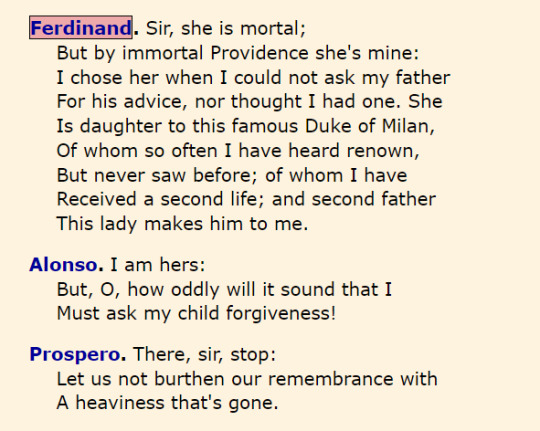
Revolutionary Girl Utena
The cycle of Utena is not immediately made clear. The show keeps to the pretense of being innocuous until well into its runtime. But then we're introduced to the Black Rose Duelists, and swiftly afterward the school's headmaster and Anthy's brother, Akio Ohtori. A former prince who styles himself as The End of the World.

Abuse, filial obligation, the horrifying reality of womanhood beneath the yoke of patriarchal systems. These cycles are grounded and are hidden by a veneer of childhood innocence and fairytale mythos. The Prince was the savior to humanity, but was selfishly hidden by a witch. This witch is therefore punished eternally for her sins, pierced by the Swords of Human Hatred. She accepts this role only as someone who loves her brother and wants to protect him. She is branded a witch by the world. But as the show says, if you're not a princess you must be a witch. That's the truth of the Rose Bride. And in the end, all girls are like the rose bride; something we're witnessing now with Miorine.

The cycle Akio implements is to groom a champion with the ideals of princehood, the champion to quest for eternity with the Rose Bride's temptation and guidance, then using the champion's sword to bash down the Rose Gate in the vain hope of regaining his princehood. It's a cycle that has repeated for countless unknown years. And all the while weaponizing his sister's suffering. But just like The Tempest, the Rose Cycle is broken by love. The unfettered and earnest love between Utena and Anthy grants the witch the courage to escape her stagnant coffin.
Ragnarok and Arthurian

The Ragnarok Cycle is a series of myths that depict the birth, reign, and death of the Norse gods. I have an ongoing series of analysis where I discussed gwitch's usage here, and here. More I'm sure will follow. But as dire as it sounds, Ragnarok isn't just about the end of the world and its many gods. It itself is a continuous cycle. The gods will return and so will the world. It's a story of renewal.
The same can be said of the Arthurian Cycle. The tales of King Arthur and uniting Britain are end-capped with a messianic promise that the King shall one day return to rule Britain. Hope, despite the tragedy that follows King Arthur upon Camlann. The fact GWitch is now harking to Arthurian with Suletta in Arthur's role (and possibly Miorine as The Lady of The Lake) is intriguing. But the bones for this twist were there from the start.

Suletta, akin to Arthur, is a child orchestrated by a 'gentle magician' to receive a peerless 'sword'. And it's through Aerial's might she becomes engaged to Miorine, a 'King's daughter. Now, it appears she's to wield Calibarn or Caliburn; a direct link to King Arthur. Whether it will go smoothly is another matter. But the reference remains interesting and again reiterates the theme of cycles.
A Hopeful Note
The ultimate take away from these references is clear in my opinion. It's no coincidence that at the forefront is a positive message that not all cycles are terrible or absolute. They can be broken with love. Gwitch is deeply humanist when you consider everything it's pulling from and I hope this settles a few doubts. Cour 2 is incredibly hopeful, even with the fraught ongoings among the cast. Our protagonist is embodying this message the clearest. Doing something for gain leads to misery. Yet a helping hand costs nothing and connects us all in a cycle itself.



#cycles can be beautiful or tragic#but they're ultimately a sign of life#g witch#g witch spoilers#suletta mercury#miorine rembran#gundam witch from mercury#rgu spoilers#the tempest#norse mythology#arthurian mythology#revolutionary girl utena#analysis and speculation
173 notes
·
View notes
Text

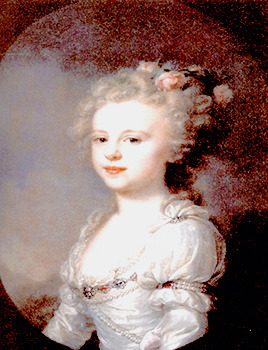


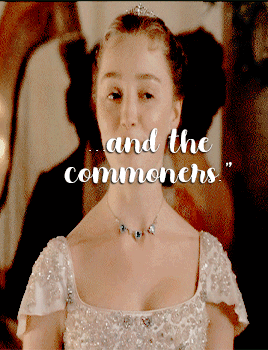
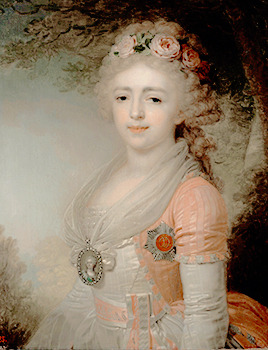
"In 1799, three years after her failed betrothal with the King of Sweden, another marital project originated for Alexandra. Previously in 1798, Dukes Ferdinand Augustus and Alexander Frederick of Württemberg who were the brothers of the Empress Maria Feodorovna, arrived in St. Petersburg to serve in the Russian army. They expressed the interest of Austria to join with Russia in a coalition against the rising power of the French Republic and Napoleon, and to cement this alliance, it was decided to arrange a marriage between Alexandra and Archduke Joseph of Austria, Palatine (Governor) of Hungary and a younger brother of Francis II, Holy Roman Emperor. Archduke Joseph personally came to Russia to see his bride. The meeting between them was successful. In mid-February 1799 the betrothal ball was held. Later, a marriage contract was signed in which Alexandra would be allowed to kept her Russian Orthodox faith. In October, Count Fyodor Rostopchin wrote:
"Believe me, that's not good started to strengthen the alliance with the Austrian court by ties of blood... Of all the sisters she will be given the least successful marriage. She will have nothing to wait for, and her children even more so."
On 25 September 1799, a decree was published about the royal title of Alexandra. In Russia, she was referred to as "Her Imperial Highness Grand Duchess the Archduchess of Austria" with the French prefix of "Palatine d'Hongrie". The wedding took place on 30 October 1799 at Gatchina Palace, one week after the wedding of her sister Elena. To celebrate both events, poet Gavrila Derzhavin wrote the ode "the wedding celebrations of 1799". On 21 November the couple went to Austria. Countess Varvara Golovina remembered that Alexandra was sad to leave Russia, and her father Emperor Paul I "constantly repeated, would not see her since her sacrifice." According to Alexandra's confessor, Andrei Samborski, Alexandra was given a cold reception in Vienna. However, other sources offer a different view. Queen Maria Carolina of Naples (the Emperor's mother-in-law) and her daughters arrived in Vienna in August 1800 for a long stay. Maria Carolina's daughter, Princess Maria Amalia of Naples, wrote in her journal that on 15 August the Queen and her daughters were introduced to Alexandra, whom she described as "very beautiful". Maria Amalia and Alexandra became friends during this time; and the Princess of Naples wrote in her journal that the Russian Grand Duchess and her husband had a friendly relationship with the rest of the imperial family and took part in the family gatherings, parties and balls in Vienna, which contrasts with the version given by Andrei Samborski. For instance, in January 1801, Maria Amalia wrote in her journal that the imperial family used to attend balls in Archduke Joseph's residence in Vienna, where "beautiful Alexandra, always serious and sad, has a magnificent household." When she was presented to Emperor Francis II, she reminded him of his first wife Elisabeth of Württemberg, who was her maternal aunt; this caused the jealousy of Empress Maria Theresa, Francis II's second wife, who also was envious of Alexandra's beauty and fine jewelry. Imperial confessor Andrew Samborski wrote:
"Remembering the happy cohabitation with her led him (the Emperor) in extreme confusion of mind which afflicted the heart of the Empress, his present wife. After this, she became in the innocent victim of the Empress' implacable vengeance...The Empress not forgotten and humiliated her parents and siblings when she called them a family of freaks, due to the treatment that Grand Duke Constantine gave to his wife."
Once, Alexandra turned up to a ball beautifully dressed, with magnificent jewellery. The Empress was incensed at being upstaged by the Archduchess, and ordered her to remove her jewellery, and also told her that she could no longer wear them. Heeding her instructions, Alexandra only decorated her hair with flowers when she attended a play some time later. The flowers highlighted her beauty, leading her to be applauded and being given a standing ovation, making Maria Theresa even more furious. Archduke Joseph could not protect his wife from these attacks. Furthermore, her Eastern Orthodox faith aroused the hostility of the Roman Catholic Austrian court, who urged her to convert. Pavlovna was popular among Hungarians, both the nobles and the commoners. According to the legend, it was her suggestion to add the color green as the third color to the flag of Hungary. Hungarians had been using red and silver, then red and green as their national colors for centuries at the time. However, in the late 18th century, a third color was proposed to be added to the flag, to follow the style of the French tricolor. Pavlovna suggested green as a symbol for hope. By the mid-19th century, the red-white-green Hungarian tricolor became widespread.
Wikipedia of Grand Duchess Alexandra Pavlovna.
81 notes
·
View notes
Text





Acri, Calabria, Italy
Acri in Calabria is sometimes described as the "door to the Sila mountains", yet the town appears impenetrable which could be due to a long history of violence.
In the Middle Ages, during the reign of the Norman King Federico II, Acri enjoyed a period of relative peace and economic prosperity, and it became an important centre for the silk trade.
In the 15th century, the power struggle between the French House of Anjou and the Spanish Crown of Aragon nearly destroyed the town. In 1462, a local duke obtained permission from the Aragonese King Ferdinand I of Naples to collect taxes in Acri. When people protested and proclaimed loyalty to the former Angevin rulers, they were seized by troops from the Aragonese army.

Even at that time, Acri must have seemed impenetrable to outsiders, for the Spanish soldiers failed to take the city, until they found a traitor who revealed the secret signals that opened the city gates. The soldiers attacked Acri with incredible cruelty, and it is estimated that 2000 citizens lost their lives. Women and children who had taken refuge in the church of Santa Maria Maggiore were burned to death, and the leader of the guards was publicly sawed in four pieces while still alive, and the limbs were exposed from the four towers of the castle.
Such history of violence is in stark contrast to the quiet peace you can experience today in Acri. But the ruins of the old castle with its one remaining tower still hover over the city as a reminder of times gone by.

Photos by Italian Notes
Follow us on Instagram, @calabria_mediterranea
#acri#calabria#italy#italia#south italy#southern italy#mediterranean#italian#city#town#cityscape#history
44 notes
·
View notes
Photo

Bellpuig Mausoleum: tomb of Ramon Folc de Cardona-Anglesola (1467-1522). Located in the Sant Nicolau de Bellpuig church in the small town of Bellpuig, Ponent, Catalonia.
Ramon Folc III was a Catalan noble born in Bellpuig, who served as an admiral and later as a viceroy of Sicily and viceroy of Naples. He was part of the Cambrai League of allies against the Kingdom of Venice, commanded the Potifician army when it sieged Bologna after this city had rebelled against the Pope, restored the Medici to Florence, and expelled France from Northern Italy, among other events. When he was viceroy of Naples, he managed to convince the king Ferdinand the Catholic not to introduce the Inquisition to the Kingdom of Naples.
Ramon Folc III died when he was viceroy of Naples. His tomb was sculpted by one of the most important Neapolitan artists of the time: Giovanni Merliano da Nola. The artist sculpted this marble monument based on a triumph arch and allegories of Ramon Folc’s virtues.
The tomb was built in Naples, taken down piece by piece, and carried on a ship and later on a carriage all the way from Naples to Bellpuig, Ramon Folc's hometown.

Photo by Luciano Pedicini. Info: Damià Amorós Albareda / Cultura i Paisatge.
#arts#escultura#renaissance#art#giovanni da nola#renaissance art#italian art#naples#napoli#napule#història#history#bellpuig#catalunya#catalonia#europe#travel#art history#beautiful places#1500s
33 notes
·
View notes
Text
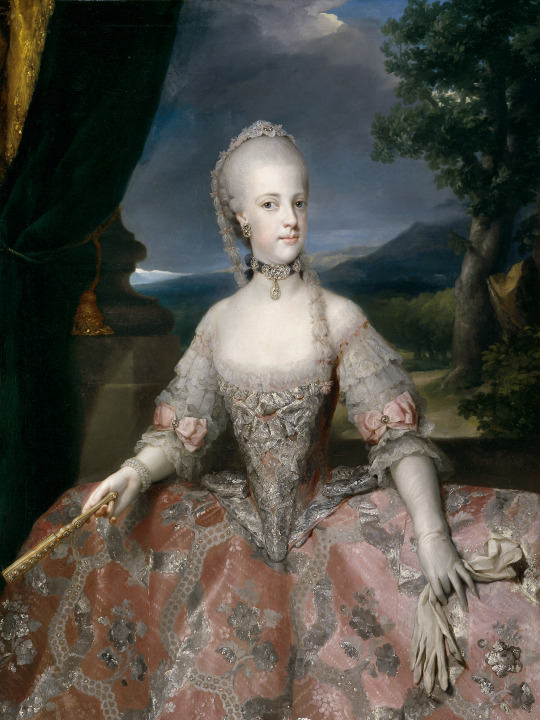

Once she [Maria Carolina] had subdued her husband and massively improved her own standing by producing a son, she had Ferdinand dismiss the old minister, against Charles III’s opposition, and replace him as state secretary with the former Sicilian emissary in Vienna. And in 1778 she began regularly attending meetings of the State Council as the heir’s mother, just as Kaunitz had initially advised her to do. In short, she showed herself to be a true daughter to her mother: not just externally but above all temperamentally. Sanguine, spirited, intelligent, and accommodating, yet also strong-willed and confrontational when necessary, she proved a masterful manipulator of her husband—albeit for her own ends, not those of her mother. She had always successfully resisted having a lady-in-waiting sent from Vienna to spy on her, and she was similarly adept at evading supervision by the imperial emissary, Wilczek. She was too much like her mother to tolerate being used as her instrument.
Maria Theresa could not begrudge her daughter her respect. In 1772 she reported to Marquise d’Herzelles: “The Queen is conducting herself very well … and I am assured that the king has already mended his boorish and filthy ways.” “I love this daughter very much, and she deserves it too,” she wrote to Countess Enzenberg, meaning: in contrast to Amalia in Parma and Antonia in Versailles. She subsequently held up Carolina to the other children as a paragon of candor and obedience, and even King Ferdinand, about whose character defects she was under no illusions, eventually rose in her estimation to become (temporarily) her second-favorite son-in-law, gendre bien aimé. She expressed herself more frankly to Maria Christina, who in 1775 was to travel to Naples to ascertain that all was in order: “You know how dear your sister is to me; justice compels me to say that she is, after you, the one who has shown me the most true inclination, asked for my advice, and heeded it too. But young and spirited as she is, partnered with so heated and ill-mannered a husband, surrounded by all possible ills, what hope can there be for her? It is a miracle that things are still running as they are, and,” she added in canny self-awareness, “more harm than good is to be expected from advice offered from abroad.”
Even Carolina had not always been open and trusting with her, she complained. That she was not quite so satisfied with her independent and strong-willed daughter in Naples as she claimed is also confirmed by Leopold, who in 1778 noted in his diary that the empress hardly bothered any more with “Neapolitan affairs as she is somewhat irritated with the queen, who does not appreciate others mixing in her business.” Toward the end of her life, pity for Carolina regained the upper hand: “The poor Queen deserves … sympathy,” she wrote in April 1780.
Stollberg-Rilinger, Barbara (2020). Maria Theresa: The Habsburg Empress in her Time (translation by Robert Savage)
#finally getting to answer my asks and i had to consult the maria theresia bible for one of them#queen maria carolina of naples#empress maria theresia#historian: barbara stollberg-rilinger#maria theresa: the habsburg empress in her time#historicwomendaily#house of habsburg
63 notes
·
View notes
Text
In that search for allies, in particular against France, English rulers had in the past largely confined themselves to two main sources: the Iberian peninsula and the Low Countries. But if any kind of effective encirclement of France was to be considered, or a joint north–south pincer-style operation undertaken, then an alliance – or at least a guarantee or likelihood of neutrality – might be sought with one or more of the Italian principalities or republics. And in the changed and changing political conditions of the later fifteenth century, a permanent English presence at the papal court in Rome, backed by Italian agents and allies, was also increasingly desirable [...] In 1463, both Ferdinand I, king of Naples, and Francesco Sforza, duke of Milan, became knights of the Order. Their evident value as potential, if not actual, opponents of French claims to Aragonese held Naples on behalf of the house of Anjou, and Sforza’s succession to the duchy of Milan in the face of French-backed Orleanist rivalry in 1450, made them potentially useful allies. Then, in 1474, Federigo da Montefeltro, duke of Urbino, was elected, while in 1480 Ercole d’Este, duke of Ferrara became a member. A greater presence of ‘foreigners’ among the knights of the Garter, especially under Edward IV and, to a slightly lesser extent Henry VII, may be revealing of England’s changed situation. Under Edward, eight were elected, of whom four were Italian, three Iberian and one Burgundian (Charles the Bold). Under Henry VII, six were elected, of whom three were Habsburgs (and therefore Austro-Spanish), two were Italian and one Scandinavian.
— Malcom Vale, 'England and Europe, c.1450–1520: Nostalgia or New Opportunities?' | The Fifteenth Century XIX: Enmity and Amity
5 notes
·
View notes
Text

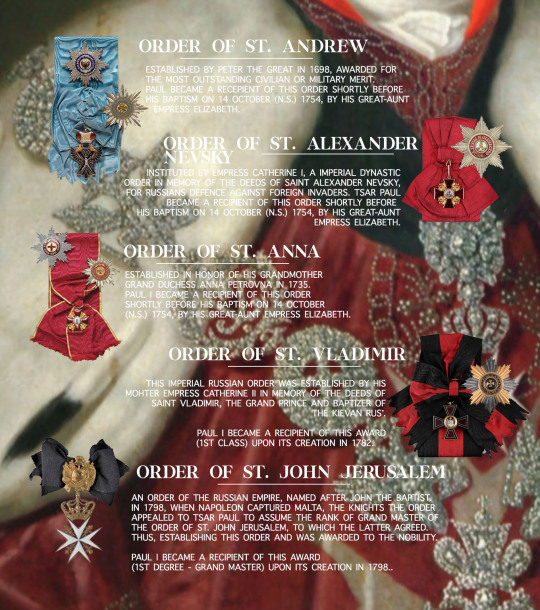
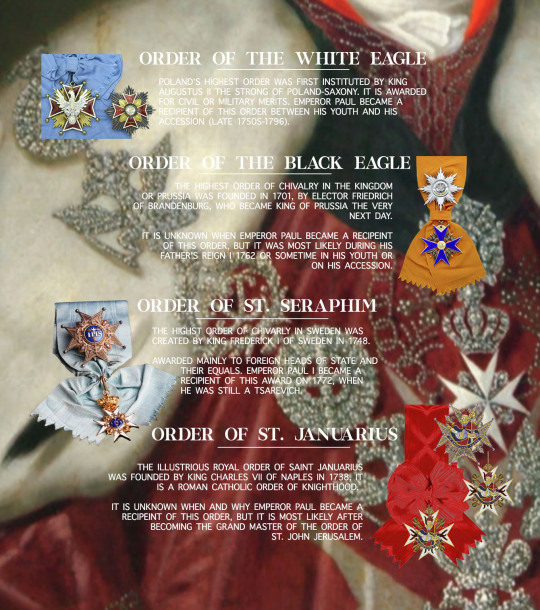

Orders and Medals → ᴇᴍᴘᴇʀᴏʀ ᴘᴀᴜʟ ɪ
Emperor Paul I of Russia, was recorded to have been a recipient of thirteen awards. Five nationals: Order of Saint Andrew, Order of Saint Alexander Nevsky, Order of Saint Anna, Order of Saint Vladimir and Order of the Saint John Jerusalem. And eight foreign: Order of the White Eagle (Poland), Order of the Black Eagle (Prussia), Order of Saint Seraphim (Sweden), Order of Saint Janarius (Naples), Neapolitan Constantine Order of Saint George (Naples), Neapolitan Order of Saint Ferdinand and Merit (Naples and Sicily), Order of the Holy Spirit (France), and Order of Our Lady of Carmel and Saint Lazarus of Jerusalem (France).
21 notes
·
View notes
Text
Day 6: Yolande of Aragon
Yolande of Aragon (also known as Yolanda de Aragón and Violant d'Aragó.)
Born: 11 August 1381
Died: 14 November 1442
Parents: John I of Aragon and Violant of Bar
Duchess of Anjou and Countess of Provence
Children: Louis III, Duke of Anjou
Marie, Queen of France
René, King of Naples
Yolande, Countess of Montfort l'Amaury
Charles, Count of Maine
Yolande was born in Zaragoza, Aragon as the eldest daughter of John I of Aragon and his second wife Violant of Bar, granddaughter of John II of France.
In 1387 a marriage offer came through the mother of the King of Naples, Louis II.
At 11 years old she signed a document that disallowed any marriage promises made by ambassadors.
In 1395 another marriage offer came from Richard II of England.
After her father’s death, her uncle was convinced to marry Yolande to Louis. She was forced to retract her protest to the marriage.
Yolande and Louis were married on December 2, 1400 in Arles.
Despite her initial rejection and her husband’s illness, they had 5 children.
As a daughter of a king, she had a claim to the throne of Aragon after her uncle’s death without an heir. The laws at the time favored male heirs, thus after two years without a king they chose Ferdinand the son of Eleanor of Aragon and John I of Castile.
Yolande’s son, Louis, was the Anjou claimant to the throne, although his claim was excluded by the Pact of Caspe..
In the second phase of the Hundred Years' War, Yolande supported the French, particularly the Armagnacs. After the attack on the Dauphin of France by the duke of Burgundy, she and her husband refused the marriage of their son Louis to the duke’s daughter.
She met with the Queen of France to arrange the marriage of her daughter and the third son of the queen, Charles.
When Charles became the Dauphin and his mother worked against his claim, Yolande became a substitute mother for the teenager. She protected him against plots, funded and helped his cause. Yolande removed Charles from his parents' court and took him to her residence where he received Joan of Arc. After his marriage to her daughter Marie she became his mother-in-law and was heavily involved in the conflict of the House of Valois.
She succeeded in having him crowned.
As her husband was often away fighting in Italy, Yolande preferred to hold court in Angers and Saumur..
After the Battle of Agincourt in 1415, the Duchy of Anjou was threatened and Louis II had Yolande, their children and Charles moved to Provence.
On 29 April 1417, Louis II died leaving Yolande, aged 33, in control of the House of Anjou. Yolande acted as regent for her young son.
Yolande not only took care of the House of Anjou but also of Charles’s cause. Yolande supported Joan of Arc from the beginning and practiced political moves to ensure the success of Charles.
She retired to Angers and then to Saumur, where she continued to play a role in politics.
From at least 1439 onwards Yolande took care and prepared her granddaughter Margaret of Anjou for marriage.
She died on 14 November 1442 at the town house of the Seigneur de Tucé in Saumur.
She is described as "the prettiest woman in the kingdom", a wise and beautiful woman and her grandson Louis XI of France described her as "a man's heart in a woman's body”.
#women history#women in history#french history#joan of arc#margaret of anjou#anjou#15th century#medieval#medieval history#1400s#france
4 notes
·
View notes
Photo
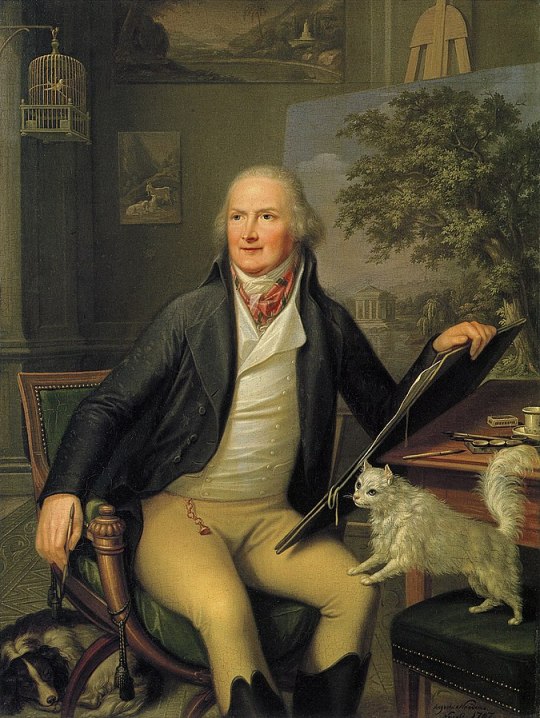
Augusto Nicodemo - Portrait of Jacob Philipp Hackert in His Studio, Naples - 1797
oil on canvas, height: 55.8 cm (21.9 in) Edit this at Wikidata; width: 42.1 cm (16.5 in)
Alte Nationalgalerie, institution Berlin State Museums, Germany
Jacob Philipp Hackert (15 September 1737 – 28 April 1807) was a landscape painter from Brandenburg, who did most of his work in Italy.
Hackert was born in 1737 in Prenzlau in the Margraviate of Brandenburg (now in Germany). He trained with his father Philipp (a portraitist and painter of animals) and his uncle, before going to the Prussian Academy of Arts in Berlin in 1758. Later he traveled to Swedish Pomerania and Stockholm, at the invitation of Adolf Friedrich von Olthof, a Swedish government official and businessman. For a time, he lived with Von Olthof and painted decorative murals at his estate.
He spent from 1765 to 1768 in Paris with the Swiss artist Balthasar Anton Dunker, where he focused on painting in gouache. He met and was inspired by Claude Joseph Vernet, who was already famous as a painter of landscapes and seascapes, and the German engraver Johann Georg Wille.
In 1768 Hackert left Paris with his brother Georg, and went to Italy, basing himself mainly in Rome and Naples, where he produced many works for Sir William Hamilton. He travelled all over Italy, gaining a reputation as a talented landscape painter. He became famous everywhere in Europe due to his works for Catherine the Great, the cycle of paintings about Battle of Chesma, and Pope Pius VI.
In 1786 he went to work for Ferdinand I of the Two Sicilies in Naples. He advised on the creation of a painting restoration laboratory at the Museo di Capodimonte, suggesting the call from Rome to the court of Naples of the restorer Federico Anders and supervised the transfer of the Farnese collections from Rome to Naples. As court painter realised famous pictures of Caserta and the Royal Palace of Caserta, besides the paintings series of the Bourobon's ports. During this period he acted also as a secret informant of Russia, his contact being the Russian diplomat Andrey Razumovsky.
When Goethe visited Naples in 1786, he and Hackert became friends.
Hackert had settled in a house in Posillipo. The painters Salvatore Fergola and Salvatore Giusti (1773-1845) were among his pupils.
In 1799, when Naples was declared the Parthenopaean Republic, Hackert lost much of his royal patronage. He moved to Pisa and then Florence. He bought an estate in San Pietro di Careggi, near Florence, and he died there in 1807 and was buried in the so-called "Dutch garden" of Livorno. His remains were then moved to the actual cemetery of the Dutch-German Congregation.
He never married and lived a good part of his life with one of his brothers but he had affairs with some married women, and from one of them he probably had a daughter.
Goethe wrote the first biography of Hackert in 1811.
15 notes
·
View notes
Note
I imagine Bourbons were worse than Murat at ruling 😂?
Murat was certainly not a perfect ruler, but even his critics acknowledged that he genuinely cared about the welfare of his Neapolitan subjects and wanted to do the best he could for them. Here are two pertinent posts I made on Project Murat comparing/contrasting the rule of Murat to that of Ferdinand, both by men who were heavily critical of Murat:
23 notes
·
View notes
Text


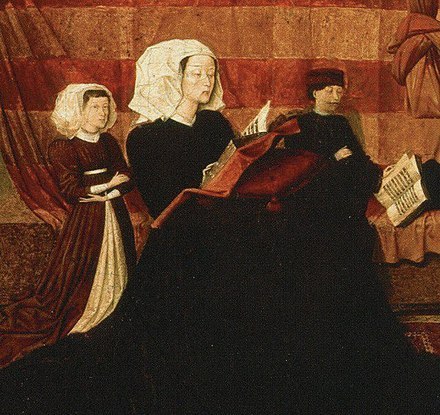







The Bastard Kings and their families
This is series of posts are complementary to this historical parallels post from the JON SNOW FORTNIGHT EVENT, and it's purpouse to discover the lives of medieval bastard kings, and the following posts are meant to collect portraits of those kings and their close relatives.
In many cases it's difficult to find contemporary art of their period, so some of the portrayals are subsequent.
1) Ferdinand I of Naples ( 1424 – 1494), son of Alfonso V of Aragon and Giraldona Carlino
2) Alfonso V of Aragon (1396 – 1458), son of Ferdinand I of Aragon and his wife Leonor de Albuquerque
3) Isabella of Taranto or Clermont (c. 1424 – 1465), daughter of Tristan of Clermont and Catherine of Taranto
4) Alfonso II of Naples ( 1448 – 1495), son of Ferdinand I of Naples and his wife Isabella of Taranto
5) Eleanor of Naples (1450 – 1493) & Beatrice of Naples (1457 – 1508), daughters of Ferdinand I of Naples and his wife Isabella of Taranto
6) Frederick I of Naples (1452 – 1504), son of Ferdinand I of Naples and his wife Isabella of Taranto
7) Ferdinand of Aragon and Guardato (before 1494–1542), son of Ferdinand I of Naples and Diana Guardato
8) Eleanor of Aragon (1402 – 1445), daughter of Ferdinand I of Aragon and Leonor de Albuquerque
9) I. John II of Aragon & Navarre (1398- 1479), son of Ferdinand I of Aragon and his wife Leonor de Albuquerque
II. Blanche I of Navarre (1385-1441), daughter of Charles III of Navarre and his wife Eleanor of Castile
III. Blanche II of Navarre (1424 – 1464), daughter of John II of Aragon and his wife Blanche I of Navarre
IV. Eleanor I of Navarre (1426 - 1479), daughter of John II of Aragon and his wife Blanche I of Navarre
V. Charles of Viana/ Charles IV of Navarre (1421- 1461), son of John II of Aragon and his wife Blanche I of Navarre
VI. Ferdinand II of Aragon & V of Castile (1452-1516), son of John II of Aragon and his wife Juana Enríquez
10)
I. Mary of Aragon ( 1403- 1445), daughter of Ferdinand I of Aragon and his wife Leonor de Albuquerque
II. John II of Castile (1405- 1454), son of Henry III of Castile and his wife Catherine of Lancaster
III. Henry IV of Castile (1425-1474), son of John II of Castile and his wife Mary of Aragon
IV. Isabella of Portugal (1428 - 1496), daughter of John of Portugal and Isabella of Barcelos
V. Isabella I of Castile (1451-1504), daughter of John II of Castile and his wife Isabella of Portugal
VI. Alfonso of Castile (1453-1468), son of John II of Castile and his wife Isabella of Portugal
#jonsnowfortnightevent2023#asoiaf#a song of ice and fire#canonjonsnow#day 10#echoes of the past#historical parallels#medieval bastard kings#bastard kings and their families#ferdinand i of naples#alfonso v of aragon#isabella of taranto#alfonso ii of naples#eleanor of naples#beatrice of naples#frederick i of naples#ferdinand of aragon and guardato#eleanor of aragon#john ii of aragon#blanche i of navarre#blanche ii of navarre#eleanor i of navarre#charles of viana#ferdinand ii of aragon#mary of aragon#john ii of castile#henry iv of castile#isabella of portugal#isabella i of castile#alfonso of castile
8 notes
·
View notes
Text
So I never did this but I tried to do my own analysis/theory of Gundam The witch from mercury and The Tempest of Shakespeare ( I think I’m not the only one tho)
I keep thinking about it since I love both piece so much lol
Might be some spoil so don’t read it if you don’t want ! I didn’t watch the prologue yet actually so I’m not fully sure about everything.
Also, it’s just my own interpretation, so don’t take it too seriously.
But if it follow the book it might be similar i guess. (I kinda spoil myself in a way lol)
I read some Tempest analysis to complete my thought too so here we are.
Let’s start with the character, since I will refer to them a lot.
Prospero, a magician on exil->Prospera Mercury/Also Delling Rembran time to time
Miranda, Prospero’s daughter ->Suletta and Miorine time to time
Ferdinand, Alonso’s son->Miorine
Ariel, an air spirit who serve Prospero->Aerial
Caliban, a monster who serve Prospero on the island ->Elan, but also Guel and sometimes Suletta actually
Alonso, King of Napples->Delling Rembran
Trinculo, Alonso Jester ->Guel
Stefano, Alonso drunken butler -> Shaddiq
Sebastian, Alonso brother->Benerit group branch families (I think Jeturk)
Antonio, Prospero brother-> Benerit group branch families (I Think Grassley)
G-Witch will be quote as GW, and The tempest book as T.
T book is about Prospero,
who was 12 years ago the rightful Duke of Milan, betrayed by his brother Antonio and the king of Naples Alonso. Nowhere to be, he is escaping with his daughter on a island, and slowly planning his vengeance by mastering magic.
Years after, the boat of The king Alonso, his son Ferdinand, his brother Sebastian, and Prospero brother Antonio, crash on the island, due to a tempest cause by one of Prospero servant, Ariel, a spirit of air.
Prospero seek for vengeance and by using Ariel magic, he is trying to manipulate everyone, even his daughter.
The book end with a happy ending, with the marriage of Ferdinand and Miranda and Ariel is break free.
In GW, what we know so far is Prospera Mercury is indeed seeking vengeance for who made her suffer in the past. She was living on Mercury, with her daughter Suletta.
Years away from other make her master magic (here gundam craftsmanship and knowledge).
As she trying to take down the all benerit group, and specially Delling Rembran, she is using her daughter Suletta to achieve her goal, along with Aerial, her servant.
The arrival of Suletta and Aerial is like the tempest at the beginning of Shakespeare book: they both shaking the entire world and statut quo, and Prospera can start her vengeance.
She is like Prospero, targeted by the 3 characters (the 3 branch of the benerit group) Trinculo (Guel, who represent Jeturk ) Stefano (Shaddiq, who represent Grassley) and Caliban (Elan, who represent Peil Tech) since they do want to take her servant away, Ariel (Gundam Aerial).
Antonio, Prospero’s brother, and Sebastian, Alonso’s brother are trying to take down Alonso.
Both of them are really similar to the two branch of the benerit group (Jeturk and Grassley) who are trying to take down Delling by attending to murder him. And let’s not forget Prospera is trying to make alliance with them.
Delling is I think, both representation of Alonso the king, and Prospero.
Prospero if a few time target by 3 characters, Trinculo (Jeturk) , Stefano (Grassley) and Caliban (Peil) as they try to kill him in his sleep.
Alonso’s son Ferdinand, here Miorine, is the primary goal of Prospero (here Prospera) vengeance:
make his daughter Miranda (Suletta), and Ferdinand (Miorine) fall in love.
Miranda is a really naive girl since she grew up on a tiny island. She doesn’t know anything about the outside world, and it fit Suletta perfectly.
Also she’s not aloud to choose her husband in the book. Her father push her in the arms of Ferdinand and they do fall in love.
Miorine and Suletta marriage/pact is all planned by her mother since the beginning.
Talking about Miorine, she’s also both Ferdinand and Miranda.
Miorine is not aloud to choose her husband due to her father rule, and she is the object of interest of Shaddiq, Guel but also Suletta (because of Prospera)
Also, in T, Ferdinand is really naive, as much as Miranda, and end up being without his knowledge a piece of the plan of Prospero.
In GW Miorine and Prospera became relatives, and with Miorine on her side, Prospera plan is going further.
Elan is I think, a character name Caliban in T book. Caliban is supposed to be half human and half monster, and he is serving Prospero as a slave on the island. He is the son of a witch name Sycorax.
And I thought It funny people from mercury are called "witches".
Caliban and Ariel are similar character, since they both represent creature/spirit Prospero can control.
And there it come, Elan is a gundam pilot and he is under "the malediction".
Caliban is supposed to be a monster deformed. He is as much an antagonist and a victim in the story (rip Elan clone), since Prospero is using him and considered him like nothing less than a human (Peil Tech)
When Aerial is the good representation of gundam, by not taking the life of his pilot, Elan and his gundam are the bad representation of it (and this explain also why people dislike gundam and Witches so much)
Caliban also try to rape Miranda in T book.
Wich Elan kinda "try" (representation) with Suletta, by forcing a kiss. Where Ferdinand (Miorine) is really in love with Miranda (Suletta) and count on marry her, Caliban (Elan) his just searching to take her virginity.
Suletta is probably also like Caliban, since I don’t believe she’s 100% human.
This would explain why Elan and Suletta are also similar in a lot of aspect.
Caliban and Ariel (Suletta and Aerial) are both servant of Prospero (Prospera).
Caliban also have struggle to speak, and Suletta difficulties to speak remind me of him.
But the thing is, actually, Guel is also a bit Caliban in his own way.
As much Miorine is Miranda sometimes, and Delling is Prospero,
Guel is actually a servant of his father and his considered as the "monster/failure".
Guel is supposed to be the king Alonso’s Jester, Trinculo, and so far he has been treat like the "risible son"who keep failing.
He has attended to force himself in Miorine life also, by intruding her beloved greenhouse and by attending duel to possess her.
Caliban like Guel, is searching for a fair master, more than power.
At the end of the book, Caliban recognised his mistake and ask for forgiveness, so I’m expecting Guel to end up being a good guy in the story. He will probably turn against his own master (his dad) and found a new master to serve.
Shaddiq is supposed to be Stefano, one of the character who try to take down Prospero.
He also searching to marry Miranda, (here Miorine) by killing her dad Prospero (here Delling).
Stefano is supposed to be the new master of Caliban in the book but I don’t see Guel/Shaddiq, or Elan/Shaddiq become the new slave/master.
If Guel is also Caliban, he will probably found his new master in the Earth house of the benerit group (probably member of Gund-Arm)
About Elan, Miorine asked him to join the new Gund-Arm company, witch makes him also the new "servant" of Prospera’s plan.
GW and T are similar in term of characters but also plot, even if I do think GW follow its own path and interpretation.
I also think some characters from GW have double character meaning, and make the plot way more complex than the original one from Shakespeare.
At the end I also think all the kids are manipulated by their own parents, to achieve their goal.
I wish we could have a happy ending, where at least the kid are forgiven for their mistakes and free from their chains, like Caliban and Ariel are in the book, but I’m not really optimistic about it. The only thing we can maybe hope for is Suletta and Miorine getting married, but will they make them, this is an other story…
Oh and if it’s not happening, well I will keep to feed the entire Suletta/Miorine fandom anyway lol
Thanks for reading my 2am thought !
#g witch#gundam#suletta mercury#miorine rembran#prospera mercury#shakespeare#the tempest#2 am ramblings#dont mind this#suletta x miorine
29 notes
·
View notes
Text
Margaret of Austria is Shipwrecked and King Henry VII of England Writes to Her at Southampton – 1497
Probably by Pieter van Coninxloo
Diptych: Philip the Handsome and Margaret of Austria
about 1493-5
https://www.nationalgallery.org.uk/paintings/GROUP20
When King Charles VIII of France put into motion his plans to extend his power basis into Italy, he attacked Naples which belonged to the sphere of influence of King Ferdinand of Aragon. Holy Roman Emperor Maximilian I concluded an anti-French…

View On WordPress
#Burgundian history#Charles V#Duke of Burgundy#Ferdinand#Henry VII#Holy Roman Emperor#Isabella#Juan Prince of Asturias#Juana of Castile#King of Aragon#King of England#Margaret of Austria#Maximilian I#medieval history#Philip the Handsome#Queen of Castile#Spanish history#Women’s history
12 notes
·
View notes
Text
Ferdinand I of Naples was known as a cruel and feared monarch during the 15th century, but one of the most fascinating parts of his rule was his collection of mummified enemies.
22 notes
·
View notes
Note
i’ve came across ur page a couple months ago and im finding it so educational and fascinating so first of all thank you for all u r sharing! now i have a question about catalan history if thats okay, i came across a post from u from a year ago or so that explains a bit why ppl from catalonia dont consider themselves spanish (being invaded and so on) but from what i read when i was in school, spain became kind of what is today bc of a marriage between the queen of castilla and king of aragon? could u point me in the right direction to learn more about spanish and catalonian history bc the last thing i want is to be disrespectful and im starting to think that i read was v biased and generally i just would like to leant more about the peninsulas history. again, thank u sm for everything u are sharing!
Thank you very much!
What you heard is true but only partially.
There are two moments that can be considered the "birth" of Spain, though the one you mention had less historical significance at the time it happened, it is more of a symbolic moment, while the one I was referring to in that post is the moment when Catalonia-Aragon stopped being independent for real.
Moment 1: the Catholic Kings
The first is the one you mention: the marriage between Isabela of Castile and Ferdinand of Aragon (known as the Catholic Kings) in 1469. This marriage means that both kingdoms (Castile and Catalonia-Aragon's confederacy of kingdoms) united their monarchy in one king.
This marriage is called a personal union. This is how Wikipedia defines it:
A personal union is the combination of two or more states that have the same monarch while their boundaries, laws, and interests remain distinct.
A real union, by contrast, would involve the constituent states being to some extent interlinked, such as by sharing some limited governmental institutions. Unlike the personal union, in a federation and a unitary state, a central (federal) government spanning all member states exists, with the degree of self-governance distinguishing the two.
This was a personal union, not a real union. So each kingdom was still independent. Think for example how England, Canada, and Australia have the same monarchy nowadays but each of them is independent from the others.
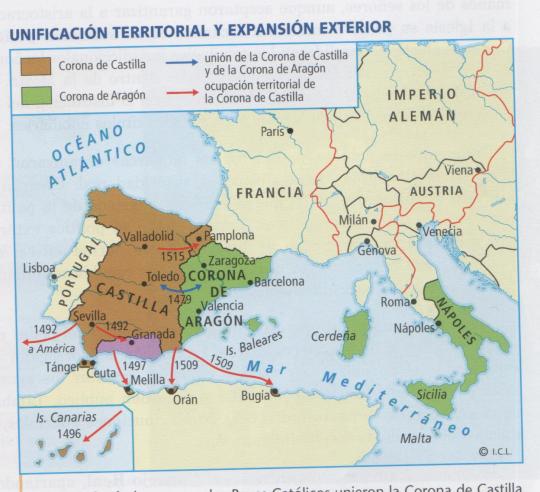
In brown, the territories of Castile. The little bit in purple in the south of the Iberian peninsula is the Kingdom of Granada, which would be conquered in the next few decades and incorporated into Castile. After Christopher Columbus's trips to America and the following colonization of the continent, the American colonies also became part of Castile (ONLY Castile, not Aragon, because they remained separate), as was stipulated by queen Isabela's will.
In green, all the kingdoms of the Aragonese confederacy. It includes Aragon, Catalonia, the Kingdom of Valencia, the Kingdom of Mallorca, the Kingdom of Naples, Sicily, and Sardinia.
The kings united, forming a single monarchy. But the countries stayed independent. There was never the intention of breaking their independence, as you can see by the fact that each kingdom still kept making their laws separately, had their own laws and customs, administration, etc. This agreement is not unusual at the times: dynasties united and splinted often. It means that the king of Aragon, Castile, Naples, etc etc etc added these new titles to his title, but it did not mean the kingdoms had become one (that's why it was important to keep listing them). But it does not mean a unification, it does not mean anyone lost their independence.
This is an interesting moment, because Castile and Catalonia-Aragon had very different understandings of monarchy and power. Castile was an absolutist monarchy, which means that the king held immense power and was the one to take decisions. On the contrary, the kingdoms of Catalonia-Aragon had a parliamentary monarchy, where the king had little power and who took the real decisions and, most importantly, who had the money to make them happen, was the Courts (a parliament comprised of representatives of the nobility, the clergy, and the citizens) and later also the Generalitat, which was formed by the Courts. In fact, this practise called “pactisme” (“agreement-ism”, distribution of power) was a central element in Catalan feudalism, if not the single most important one. Castile’s absolutism was the opposite of it. The Courts stayed active between the 13th and the 18th centuries, they were dissolved after Castile's invasion of 1714.
Now, two monarchies becoming one when they have such different ways of working, different powers, and different customs in the territories they rule was bound to bring problems. In fact, the monarchy became centred on Castile, since that's where they had more power. With time, the kings understood their power more and more in the Castilian way, that they were appointed by God and should have the power to take decisions by themselves. In Catalonia-Aragon this was seen as a danger and caused revolutions, wars (such as Corpus de sang, the Reaper’s War, the 1641 Catalan Republic, or the War of the Brotherhoods) and political confrontation with the Courts. Castile was slowly trying to impose their model based on a centralized absolutist power as the same time as they became an imperial global superpower. Despite their insistences, the kingdoms were still independent both de jure and de facto, with their own Constitutions, laws, etc.
The marriage of the Catholic Kings, as seen, was not “the birth of Spain”, because “Spain” as a state still didn’t exist. (At the time, Hispania was a geographical name that meant what we now call the Iberian Peninsula). However, this moment was used by Spanish nationalism as a “birth” moment, particularly in the 19th century’s nationalism, and it was given most importance by the education system of Franco’s fascist dictatorship, who forced all schools to teach Spanish patriotism as a subject and whose curriculum for other subjects was also heavily drawn on Spanish-Castilian supremacy.
Moment 2: the War of Spanish Succession
This is the event that led to the unification of the kingdoms and created the state of Spain.
In the year 1700, the king Charles II the Bewitched died with no heir, as a result of being highly inbred. This same reason made him be disabled in many ways, including mentally. That’s why he couldn’t take many decisions by himself and was often a puppet of his ministers.
The court saw that he would die without descendants and two sides formed:
Those who wanted Philip, Duke of Anjou. He was from the Bourbon family, in fact he was the grandson of the king of France Louis XIV. France was the most authoritative, centralist, and absolutist monarchy, so this is how the kingdoms of Spain would be ruled under him. It would be beneficial to have the House of Bourbon rule both Spain and France, which were the two biggest empires in the world. Their power would be absolute internationally. This was the side chosen by Castile.
Those who wanted the Archduke Charles of Austria, brother of the Emperor of the Holy Roman Empire (aka Germany and its surroundings). They were from the Habsburg family, same as the king who died, so them being relatives meant he had a claim to the throne. This king vowed to keep the independence of each territory, respect their laws, customs, and languages, and keep things as they were. This was the side chosen by the Catalan-Aragonese confederacy. Other countries such as England, Portugal and the Netherlands showed support to this side too, because they wanted to avoid one single dynasty ruling most of the world, as would be the case with the Bourbons.
Right before dying, the nobles of Charles the Bewitched’s court managed to make him sign a will saying his successor would be Philip of Anjou, who then became Philip V of Castile and Philip IV of Aragon. The emperor of the Holy Roman Empire reminded the court that his family was the one who had the dynastical right to be the heirs, and so a war started.
This was soon became a desperate war to keep a political system, not only about the king. And then (especially after the Battle of Almansa in 1707) it became a war of invasion. Castile won the war, occupying all the territories and massacring populations. The war ended when Barcelona surrendered after a terrible siege on the 11th of September 1714, though technically some places resisted until 1715.
When Castile occupied each kingdom of the Catalan-Aragonese crown, they released a Decree called “Nueva Planta” (which means “New Plant”). These decrees state that the king Philip V eliminates the governments of each kingdom, and now all of them will be ruled by the laws of Castile. This means the end of the independence of all these kingdoms, the end of their administrations, their traditional laws and customs. The decrees also impose the Spanish language, the Spanish centralized monarchy, imposed Castilian gobernadores (colonial governors) in the occupied territories, forbids the Catalan-Aragonese population from things like owning knives, makes them pay taxes to cover the costs of the war, changes the names of cities to Spanish names, among many other things. We explained the decree better in this previous post.
For this reason, the War of the Spanish Succession was the moment when Spain started to exist as a political unity. Don’t take my word on it: take the world of Charles V himself. Now there was a Spain, created by the expansion of Castile.
---------------------------------------------------------
I hope this was not too long, if I didn’t make myself understood do not hesitate to ask for clarification. If you want to learn more, you can check out this blog’s tag #guerra de successió.
Once again, thank you for your interest!
#ask#anonymous#història#guerra de successió#war of the spanish succession#war of spanish succession#kingdom of aragon#aragon#catalonia#18th century#1714
54 notes
·
View notes